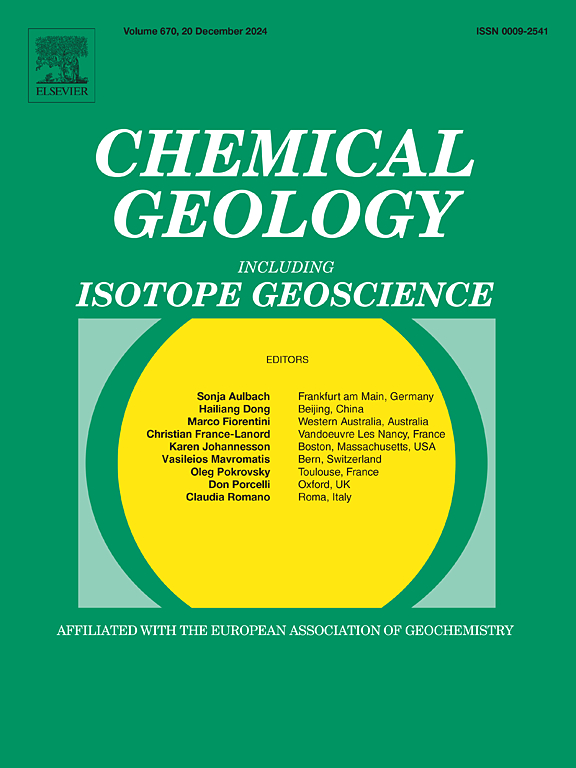Seawater temperatures during the early to middle Ediacaran: Phosphate oxygen isotope records
IF 3.6
2区 地球科学
Q1 GEOCHEMISTRY & GEOPHYSICS
引用次数: 0
Abstract
Early multicellular eukaryotes are hypothesized to have first evolved in deep-water (i.e., subphotic) environments with a narrow temperature range and low oxygen levels (pO2). However, seawater paleotemperature estimates for the Ediacaran Period remain poorly known. To address this issue, we measured the oxygen isotopic compositions of phosphate (δ18OP) in fine-grained marine siliciclastic sedimentary rocks from two slope sections of the Doushantuo Formation (∼635–551 Ma) in the Nanhua Basin, South China. The bulk δ18OP values (∼19–26 ‰) found in early-middle Ediacaran phosphatic marine shales represent the oldest known records of modern seawater-like δ18OP values. These values are inferred to record original seawater signatures and suggest that subtropical surface temperatures had a modern-like range of 15–30 °C. Based on these estimates, we propose that the extreme greenhouse conditions of the earliest Ediacaran following the Marinoan Ice Age were of quite short duration (<∼0.1 Myr). Subsequently, the oldest known metazoan fossil assemblage, the Lantian Biota (∼602 Ma), thrived in a deep-water environment characterized by low oxygen levels and a relatively cold, narrow temperature range (∼7–8 ± 2 °C). In contrast, the slightly younger Weng'an Biota (∼587 Ma) inhabited shallower waters with higher oxygen levels and a broader temperature range (16–30 °C). Finally, our evidence shows that the oxygen isotopic composition of phosphate in fine-grained siliciclastic marine sedimentary rocks can serve as a valuable proxy for reconstructing the temperature of ancient seawater. Such paleotemperature information, combined with oxygen concentration data, is crucial for understanding the origin and evolution of early animal life.
求助全文
约1分钟内获得全文
求助全文
来源期刊

Chemical Geology
地学-地球化学与地球物理
CiteScore
7.20
自引率
10.30%
发文量
374
审稿时长
3.6 months
期刊介绍:
Chemical Geology is an international journal that publishes original research papers on isotopic and elemental geochemistry, geochronology and cosmochemistry.
The Journal focuses on chemical processes in igneous, metamorphic, and sedimentary petrology, low- and high-temperature aqueous solutions, biogeochemistry, the environment and cosmochemistry.
Papers that are field, experimentally, or computationally based are appropriate if they are of broad international interest. The Journal generally does not publish papers that are primarily of regional or local interest, or which are primarily focused on remediation and applied geochemistry.
The Journal also welcomes innovative papers dealing with significant analytical advances that are of wide interest in the community and extend significantly beyond the scope of what would be included in the methods section of a standard research paper.
 求助内容:
求助内容: 应助结果提醒方式:
应助结果提醒方式:


